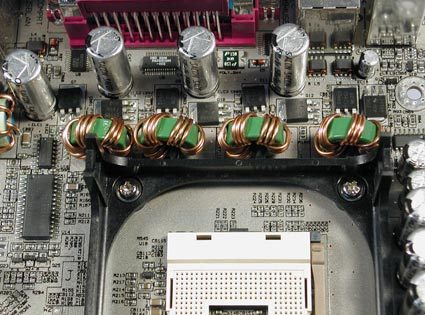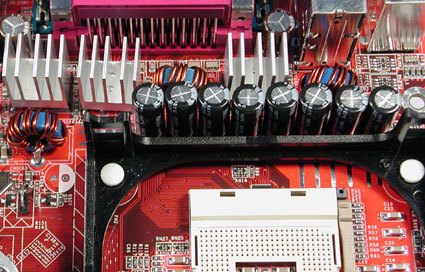All Aboard! P4 with 200 MHz FSB and the i875P Dual DDR400 Chipset
CPU Core Voltage: Not Necessarily 1.55 Volt
With the 200 MHz FSB variant, Intel introduces four new voltage categories (VIDs). Instead of orienting itself towards the well-known 1.55V norm, the processor powerhouse has decided to keep the specification of the core voltage (Vcore) flexible. Based on the selection process during production, the CPUs are divided into four classes. The voltages now range from 1.475 to 1.550 Volt. For friends of overclocking, the models with the smallest core voltage will be interesting because the of potential for clock rate increases. The following table shows you the four voltage categories:
| VID | Vcc Max | Vcc Min |
|---|---|---|
| 1.550 V | 1.425 V | 1.340 V |
| 1.525 V | 1.400 V | 1.315 V |
| 1.500 V | 1.375 V | 1.290 V |
| 1.475 V | 1.350 V | 1.265 V |
VID possibilities for Intel's new P4 processors.
The thermal dissipation of the Pentium 4 3.00 GHz has changed only marginally when compared to that of the 3.06 GHz model. When comparing the 1.55 Volt models, the difference is just barely 0.1 Watt.
Furthermore, in studying the new voltage regulator specification VRM10.0, we make another interesting discovery: Intel wants to push its P4 (Willamette core) off the market faster. And so it was shown that the VRM10.0 no longer provides for the higher voltages of the Willamette. According to this, there is to be no further support for the old Pentium 4. The VRM10.0 helps the motherboard manufacturers save on costs - because the voltage range is lowered, this means that components could be cheaper. In any case, the VRM10.0 is not mandatory. If a motherboard manufacturer wants to continue to support the Willamette, for example, the regulators need only be properly designed for the extended voltage range.
Low heat development: four-phase voltage regulator on the 875P board from Soyo.
Cooling against high temperatures: three-phase voltage regulator on the Canterwood board from MSI.
Rather expensive with Gigabyte: three-phase voltage regulator on the 875P motherboard; four phases in additional cards.
Get Tom's Hardware's best news and in-depth reviews, straight to your inbox.
Current page: CPU Core Voltage: Not Necessarily 1.55 Volt
Prev Page Overview: Market Launch Dates For The Latest Intel And AMD CPUs Next Page Test Setup


